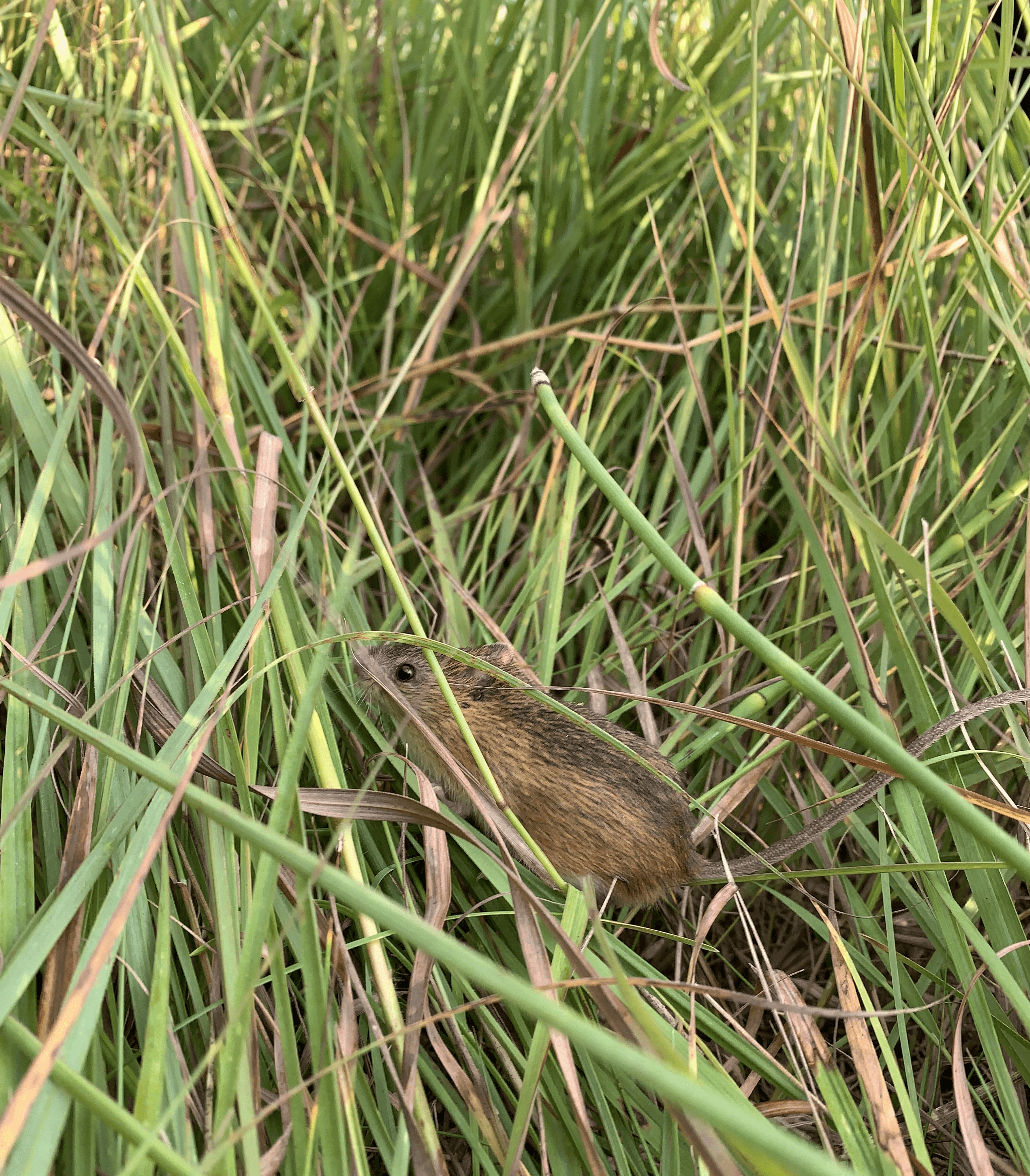
A newly released Meadow Jumping Mouse (Zapus hudsonius).
Every year the Crane Trust science team traps small mammals between August 15th and September 21st. Setting and baiting 50 Sherman Box Traps at each monitoring plot two hours before sunset each night and checking them each morning. In one week we usually set traps in two to three monitoring plots for three nights. Last week was my first time helping with this protocol and I'd like to share a little bit about it with you.
Before trapping we have to lay out our 200m transect. To do this we bring two 100m measuring tapes, a GPS, and a compass. Using the GPS we locate the monitoring plot’s starting point and pull a 100m line to the middle point. From the middle point to the end, we use a compass to help us continue our straight 200m line. From here we set traps every five meters and at two random points along the line. As we go we bait the traps with baked black oil sunflower seeds, cracked corn, and common oats, mark the hard-to-see traps, and mark the beginning, middle, and end. Then we leave and return the next morning.
In the morning we will check for our fuzzy friends. When there is an open trap we close it and if there is a closed trap we check it. If a small mammal is inside, then we use a dichotomous key to identify what species was caught, determine its sex, if it is reproductive and what proved that the mammal was reproductive, figure out if it is an adult or not with additional body measurements when needed, and note any ticks or strange markings. Some of the features that prove a small mammal is reproductive include being scrotal, pregnant, or lactating. When figuring out if they are adults we look at head and body length, tail length, hind length, ear length, and weight.
Species Caught Our First Round of Trapping
- Peromyscus maniculatus bairdii- Prairie Deer Mouse
- Microtus pennsylvanicus- Meadow Vole
- Reithrodontomys montanus- Plains Harvest Mouse
- Zapus hudsonius- Meadow Jumping Mouse
- Reithrodontomys megalotis- Western Harvest Mouse
We study these species to understand how our management practices are affecting their populations. It turns out they are sensitive to changes brought by fire frequency, grazing activity, and woody encroachment. By understanding the shifts in the small mammal community we can take a more evidence-based approach to create better habitat for them and, in turn, provide more resources for raptors, cranes, and other carnivores. From a wider view, we are supporting our whooping cranes, sandhill cranes, mesocarnivores, and all the other predatory species that rely on small mammals as a food source by monitoring their populations' health. This helps keep the whole system more balanced. When plants thrive our herbivores do well, when our herbivores do well the predators above them do well too. In protecting our lower trophic levels, like our small mammals, we protect the higher trophic levels too; providing them with needed habitat and food sources.
I have found that small mammal surveys take a lot of time compared to other animal groups. Setting traps, checking traps, and identifying trapped species for four days. In the process of completing this protocol, we had a week that was too hot for trapping, which is abnormal. Usually, cold days or bad weather are what slow down small mammal season, but not this year so far. Another cool thing I am excited that we could end up handling shrews, which are venomous and have very high metabolisms.
Shrew Species
- Sorex cinereus- Cinereus Shrew
- Sorex hayendi- Prairie Shrew
- Blarina brevicauda- Northern Short-Tailed Shrew
- Cryptotis parva- Least Shrew
Their venom is not strong enough to seriously harm or kill a human, but it is used on their prey, insects. We include mealworms in our bait since shrews’ metabolisms require protein constantly throughout the day and night, unlike the other small mammals we catch.
The newest part of this process, for me, has been using a dichotomous key. A dichotomous key gives you a list of organized yes or no questions to help you identify what species you are handling. Imagine you are looking at a mouse that looks very similar to other species. You would go through a list of questions like the one shown below to figure out what species of mouse you trapped.
1a. Head and body longer than 79 mm…………………………………….………...………………..2
1b. Head and body shorter than 79 mm……………………………………………………………..…3
2a. Possess a tuft of fur at end of tail…………………….…...Brush Mouse (Peromyscus boylii)
2b. Does not possess a tuft of fur at end of tail..White-Footed Mouse (Peromyscus leucopus)
3a. White fur on ventral side and tail is same length or longer than the head and body combined…….……………………….…Western Harvest Mouse (Reithrodontomys megalotis)
3b. Whitish fur on ventral side and tail is shorter than the head and body combined………………
……………………………………………Plains Harvest Mouse (Reithrodontomys montanus)
This is a very simplified example in comparison to the 21-step dichotomous key we take into the field. These keys are not difficult to use, but take time to use well.
I hope you enjoyed learning about small mammal surveys today!
See you in the next blog,
Matt Urbanski, Saunders Conservation Fellow

